In an ideal world, I’d create more resources for hypopara patients
I wish there'd been a manual that told me what to expect

“We’re all in this together/ When we reach/ We can fly/ Know inside/ We can make it/ We’re all in this together.” – “High School Musical”
When I was diagnosed with hypoparathyroidism after having surgery for Graves’ disease in 1998, I thought I was the only person with this rare condition. Nobody explained it differently to me. The only guidance I received was, “Just take some calcium, and you’ll be fine.”
It was a scary time. I knew nothing about hypoparathyroidism, including how to live with it, its long-term consequences, or how it is treated.
I didn’t really research the disorder until I had a life-altering calcium crash in 2016. While I was recovering, I came across the name of endocrinologist Michael Mannstadt, currently the head of the Endocrine Unit at Massachusetts General Hospital in Boston, in several research papers. That ultimately led me to speak with him.
Mannstadt was the first doctor to explain hypoparathyroidism to me. His expertise and experience gave me hope and provided a road map for stability. I transitioned from Natpara (recombinant human parathyroid hormone), which was recalled in 2019, to the standard of care, which includes calcium and calcitriol, a form of vitamin D3.
Mannstadt changed my perception about living with hypoparathyroidism by reassuring me that I’d made it this far, with two healthy pregnancies, and nothing bad was going to happen under his care. He introduced me to the Hypoparathyroidism Association, an organization that advocates and provides support and education for hypoparathyroidism patients. This connection to a community gave me a sense of belonging and affirmed the importance of community support.
I wish there’d been a manual when I was diagnosed that told me what to expect, like there was when I was pregnant. Perhaps something like “What to Expect When Diagnosed with Hypoparathyroidism.” I believe the hypopara community would benefit from a resource like that. I certainly would’ve done things differently had I known then what I know now.
Even with incredible advancements in science, new patients continue to be diagnosed with this disorder. Fortunately, for those diagnosed today, a wealth of information and resources is available, although they’re scattered across the internet. It’d be nice if they were all in one place and had a “What to Expect” section, like the information I was able to access regarding pregnancy.
It takes time to research, and many people with hypopara experience brain fog and have trouble concentrating. Having a streamlined website would be so beneficial.
If I were to write a book or create a website based on “What to Expect When Diagnosed with Hypoparathyroidism,” I’d include information about how patients and caregivers with various conditions can help researchers. One way I currently do that is by filling out paid surveys for Rare Patient Voice, a company that aims to improve medical products and services by allowing patients and caregivers to voice their opinions. It feels great to be heard, and even better when a check arrives to compensate me for my valuable time.
I’d also provide information about financial support programs like the Assistance Fund, which offers financial support for copayments, coinsurance, deductibles, and other health-related expenses. For example, the first question many hypopara patients ask when researching Yorvipath (palopegteriparatide) is, “How much will this cost me?” With financial assistance, patients instead can ask questions like, “How can this drug help me?” And, “What are the long-term consequences?” Financial support can provide a sense of security and relief, allowing patients to focus on their health and well-being.
If I were creating an ideal resource, I’d ask questions like, “How can I help and support you?” I’d hold weekly Zoom calls, because sometimes an understanding face is the best medicine.
After living with hypoparathyroidism for more than half of my life, I know what’s lacking and what could be improved. Community involvement is key. I’m grateful to have a platform here at Hypoparathyroidism News to share my journey and spread my wings of hope to all of the brave butterflies. Together we will make it. Let’s hold on to hope, as it is the fuel that keeps us going and the promise of a brighter future.
Note: Hypoparathyroidism News is strictly a news and information website about the disease. It does not provide medical advice, diagnosis, or treatment. This content is not intended to be a substitute for professional medical advice, diagnosis, or treatment. Always seek the advice of your physician or another qualified health provider with any questions you may have regarding a medical condition. Never disregard professional medical advice or delay in seeking it because of something you have read on this website. The opinions expressed in this column are not those of Hypoparathyroidism News or its parent company, Bionews, and are intended to spark discussion about issues pertaining to hypoparathyroidism.







Leave a comment
Fill in the required fields to post. Your email address will not be published.